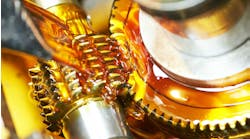Hydraulic Oil Contamination: How Its 'Cure' Can Be Worse Than The Disease
Given that removing contaminants from the oil to extend hydraulic component life is the primary objective of filtration, it is a paradox for filters to be located where they reduce the service life of components they were installed to protect.
So when considering the possible locations for filters in a hydraulic system, the overarching principle should be: first, do no harm. From a filtration perspective the pump intake is an ideal location for filtering media. Filter efficiency is increased by the absence of both high fluid velocity, which can disturb trapped particles, and high pressure-drop across the element, which can force migration of particles through the media. These advantages are outweighed by the restriction the element creates in the intake line and the negative effect this can have on pump life.
A restriction at the pump inlet can cause cavitation erosion and mechanical damage. And while cavitation erosion contaminates the hydraulic fluid and damages critical surfaces, the mechanical effect of vacuum-induced forces has a more detrimental impact on pump life.
The creation of a vacuum in the pumping chambers of an axial pump puts the piston-ball and slipper-pad socket in tension. This joint is not designed to withstand excessive tensile force and as a consequence, the slipper becomes detached from the piston. This can occur either instantaneously, if the vacuum-induced tensile force is significant enough, or over many hours of service as the ball joint is repetitively put in tension during inlet.
The piston retaining plate, the primary function of which is to keep the piston slippers in contact with the swash plate, must resist the forces that act to separate the piston from its slipper. This vacuum-induced load accelerates wear between the slipper and retaining plate and can cause the retaining plate to buckle. If this happens it allows the slipper to lose contact with the swash plate during inlet, and it is then hammered back onto the swash plate when pressurized fluid acts on the end of the piston during outlet. The impact damages the piston slippers and swash plate, leading rapidly to catastrophic failure.
In bent axis pump designs, the piston is better able to withstand vacuum-induced tensile forces. Piston construction is generally more rugged and the piston ball is usually held in its shaft socket by a bolted retaining plate. However, tensile failure of the piston stem and/or buckling of the retaining plate can still occur under high vacuum conditions.
In vane pump designs, the vanes must extend from their retracted position in the rotor during inlet. As this happens, fluid from the pump inlet fills the void in the rotor created by the extending vane. If excessive vacuum exists at the pump inlet - it will act at the base of the vane. This causes the vanes to lose contact with the cam ring during inlet, and they are then hammered back onto the cam ring as pressurized fluid acts on the base of the vane during outlet. The impact damages the vane tips and cam ring, leading rapidly to catastrophic failure.
Gear pumps are mechanically the least susceptible to vacuum-induced forces. Despite this fact, research has shown that a restricted intake can reduce the service life of an external gear pump by at least 50 percent.
Pump inlet or suction filters usually take the form of a 150-micron (100-mesh) strainer, which is screwed onto the pump intake penetration inside the tank. In the 10 years I've actively campaigned against their use - for the reasons outlined above - I'm sure I've heard all the counter arguments. And most arguments for the use of suction strainers are premised on bad design, bad maintenance, or a combination of both.
The argument that suction strainers are needed to protect the pump from debris which enters the tank as a result of poor maintenance practices is a popular one. The reality is nuts, bolts, tools and similar debris pose minimal threat to the pump in a properly designed reservoir, where the pump intake penetration is located a minimum of four inches off the bottom. Of course, the proper solution is to prevent contaminants from entering the tank in the first place.
A similar argument asserts that suction strainers are needed to prevent cross contamination where two or more pumps share a common inlet manifold. Here again, if suction strainers are necessary in this situation, then it is only due to bad design: the manifold is below the pumps' intakes. If properly designed, there should be a head of oil above the inlet manifold and the inlet manifold should be above the pumps' inlet ports. For cross contamination to occur in this arrangement, debris would have to travel uphill - against gravity and a positive head of oil. Something which is highly unlikely.
But even in situations where a suction strainer is mandated - for whatever reason, the problem is: the cure can actually be worse than the disease. In other words, installing a filter of any kind in a pump intake line can be a costly mistake. And to discover six other costly mistakes you want to be sure to avoid with your hydraulic equipment, get "Six Costly Mistakes Most Hydraulics Users Make... And How You Can Avoid Them!" available for FREE download here.
